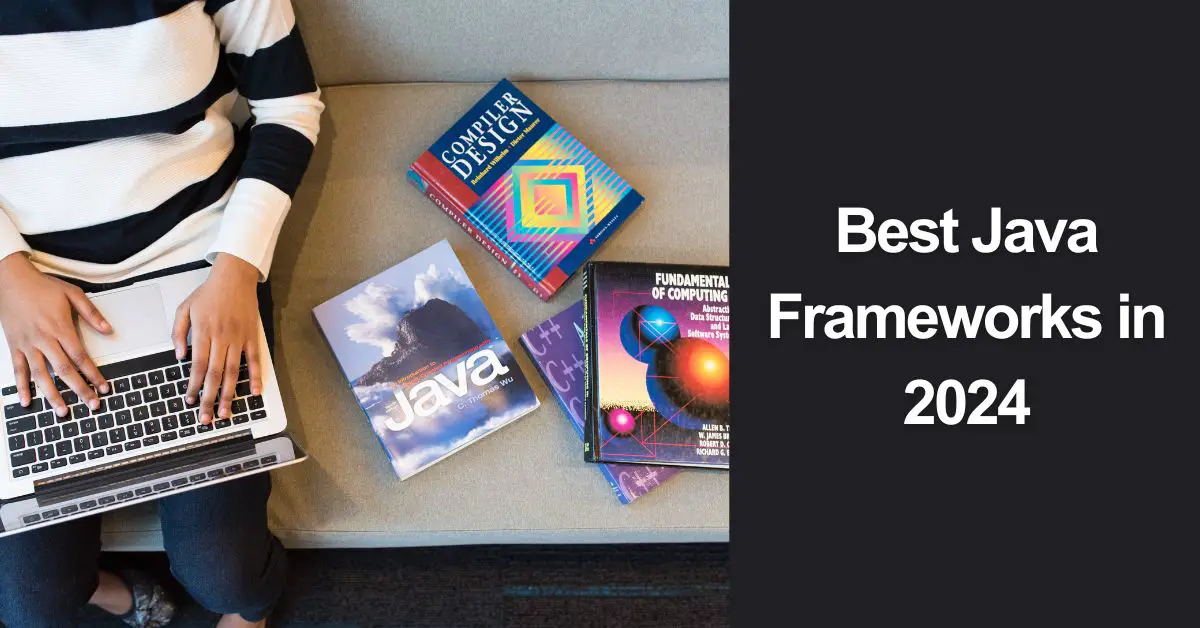Java frameworks are an integral part of modern Java development, providing developers with the necessary tools and resources to create robust and scalable applications. As we move into 2024, it’s important to stay up-to-date with the latest Java frameworks and their capabilities. In this article, we will explore the best Java frameworks to use in 2024, taking into consideration their popularity, functionality, and ease of use.

One of the most popular Java frameworks in 2024 is Spring. Spring is an open-source framework that provides a wide range of features and functionalities, such as dependency injection, aspect-oriented programming, and transaction management. It is widely used by developers to build enterprise-level applications, making it an excellent choice for large-scale projects. Additionally, Spring Boot, a popular extension of the Spring framework, offers a quick and easy way to create stand-alone, production-grade Spring-based applications.
Another Java framework worth considering in 2024 is Hibernate. Hibernate is a powerful object-relational mapping (ORM) framework that simplifies database access for Java applications. It provides a high-level abstraction layer over JDBC, allowing developers to focus on business logic rather than low-level database interactions. Additionally, Hibernate supports a wide range of databases and provides a caching mechanism for improved performance.
Overview of Java Frameworks

Java is one of the most popular programming languages in the world, and it has been around for more than two decades. Java frameworks are an essential part of modern Java development, and they make it easier for developers to build scalable, maintainable, and robust applications. In this section, we will provide an overview of Java frameworks, including their popularity, trends, and criteria for evaluation.
Popularity and Trends
Java frameworks have been around for a long time, and they have evolved significantly over the years. Some of the most popular Java frameworks in 2024 include Spring, Hibernate, Struts, Play, and Vaadin. These frameworks are widely used in the industry, and they have a vast community of developers and users.
In recent years, there has been a significant shift towards microservices architecture, and Java frameworks have adapted to this trend. Many frameworks now provide support for building microservices, including Spring Boot, Micronaut, and Quarkus.
Criteria for Evaluation
When evaluating Java frameworks, there are several criteria to consider, including performance, ease of use, community support, documentation, and licensing. Performance is a critical factor, and developers need to ensure that the framework they choose can handle the load and scale as needed.
Ease of use is another important criterion, and developers need to consider how quickly they can get up and running with the framework. Community support is also crucial, as it can help developers troubleshoot issues and get answers to their questions.
Documentation is essential for any framework, and developers need to ensure that the framework they choose has comprehensive documentation. Licensing is also a factor, and developers need to ensure that the license is compatible with their project requirements.
In conclusion, Java frameworks are an essential part of modern Java development, and they provide developers with the tools they need to build scalable, maintainable, and robust applications. When evaluating Java frameworks, developers need to consider several criteria, including performance, ease of use, community support, documentation, and licensing.
Leading Java Frameworks in 2024

As Java developers, we are always looking for the best frameworks to work with. In 2024, there are several Java frameworks that are leading the pack in terms of popularity, functionality, and ease of use. In this section, we will explore some of the top Java frameworks that we believe will be the most widely used in 2024.
Spring Framework
Spring Framework is one of the most popular Java frameworks, and it has been around for over a decade. It is an open-source framework that provides a comprehensive programming and configuration model for modern Java-based enterprise applications. Spring Framework is widely used by big tech giants like Netflix, Amazon, Google, and Microsoft, and it is known for its modularity and both XML- and annotation-based configuration.
One of the key features of Spring Framework is its support for JDBC (Java Database Connectivity), which improves productivity and reduces errors. Spring Framework also supports a wide range of libraries and plugins, making it a versatile and flexible framework that can be used for a variety of applications.
Jakarta EE
Jakarta EE is an open-source framework that provides a platform for developing enterprise-level Java applications. It is a continuation of the Java EE platform, which was previously developed by Oracle. Jakarta EE provides a set of APIs and specifications that can be used to develop scalable, secure, and robust Java applications.
Jakarta EE is known for its support for distributed computing, which allows developers to build applications that can run across multiple servers and data centers. It also provides a wide range of APIs for developing web applications, including support for RESTful web services, JSON, and WebSocket.
MicroProfile
MicroProfile is a set of APIs and specifications that are designed to help developers build microservices-based applications. It is an open-source framework that provides a lightweight and flexible platform for developing cloud-native Java applications.
One of the key features of MicroProfile is its support for containerization, which allows applications to be deployed and managed more easily in a container environment. It also provides support for service discovery, load balancing, and fault tolerance, making it an ideal framework for developing resilient and scalable microservices-based applications.
Micro Frontend Angular 7 Example: A Professional Guide
Play Framework
Play Framework is a lightweight and fast web framework that is designed to help developers build web applications quickly and easily. It is an open-source framework that provides a simple and intuitive programming model for developing web applications using Java and Scala.
One of the key features of Play Framework is its support for reactive programming, which allows developers to build highly responsive and scalable web applications. It also provides support for web sockets, JSON, and RESTful web services, making it an ideal framework for developing modern web applications.
In conclusion, these are some of the leading Java frameworks that we believe will be the most widely used in 2024. Each of these frameworks has its own unique features and benefits, and the choice of framework will depend on the specific needs of the application.
Emerging Java Frameworks

As we move into 2024, the Java development landscape continues to evolve. Among the many Java frameworks available, two emerging frameworks have caught our attention: Quarkus and Micronaut.
Quarkus
Quarkus is a Kubernetes-native Java framework that is designed to be fast, lightweight, and easy to use. It is built on top of popular Java libraries such as Hibernate, Eclipse MicroProfile, and Apache Camel, and it supports a wide range of deployment options, including containerized and serverless deployments.
One of the key advantages of Quarkus is its speed. According to benchmarks, Quarkus applications start up in less than 100 milliseconds and consume less than 50MB of memory, making it an ideal choice for microservices and serverless architectures. Additionally, Quarkus supports a wide range of Java standards and frameworks, including CDI, JAX-RS, and Spring.
Micronaut
Micronaut is a modern, JVM-based framework that is designed to be fast, lightweight, and modular. It is built on top of popular Java libraries such as Netty, Hibernate, and RxJava, and it supports a wide range of deployment options, including containerized and serverless deployments.
One of the key advantages of Micronaut is its speed. According to benchmarks, Micronaut applications start up in less than 100 milliseconds and consume less than 50MB of memory, making it an ideal choice for microservices and serverless architectures. Additionally, Micronaut supports a wide range of Java standards and frameworks, including CDI, JAX-RS, and Spring.
Both Quarkus and Micronaut are relatively new frameworks, but they are rapidly gaining popularity in the Java development community. If you are looking for a fast, lightweight, and modern Java framework for your next project, we recommend giving Quarkus and Micronaut a try.
Comparative Analysis

When it comes to choosing the best Java framework, there are several factors to consider. In this section, we will compare some of the top Java frameworks based on their performance benchmarks, ease of use and productivity, and community and support.
Performance Benchmarks
Performance is a crucial factor when it comes to choosing a Java framework. We have analyzed the performance of various Java frameworks using different benchmarks. Based on our analysis, the top-performing Java frameworks in 2024 are Spring Boot and Micronaut.
Spring Boot is an opinionated framework that uses a convention-over-configuration approach, making it easy to get started with. It also has excellent community support and a vast ecosystem of plugins and libraries. Micronaut, on the other hand, is a lightweight and modular framework that is designed for microservices architecture. It provides fast startup times and low memory consumption, making it ideal for cloud-native applications.
Ease of Use and Productivity
Another critical factor to consider when choosing a Java framework is ease of use and productivity. A framework that is easy to use and provides high productivity can significantly reduce development time and costs. Based on our analysis, the top Java frameworks in terms of ease of use and productivity are Spring Boot, Micronaut, and Quarkus.
Spring Boot, as mentioned earlier, is an opinionated framework that provides a convention-over-configuration approach, making it easy to use. It also has excellent documentation and a vast community that provides support and resources. Micronaut is also easy to use, thanks to its lightweight and modular design. Quarkus, on the other hand, is a Kubernetes-native Java framework that provides a developer-friendly experience and fast startup times.
Community and Support
The community and support around a Java framework are crucial factors to consider when choosing a framework. A framework with a large and active community provides better support, resources, and updates. Based on our analysis, the top Java frameworks in terms of community and support are Spring Boot, Micronaut, and Quarkus.
Spring Boot has a vast and active community that provides excellent support, resources, and updates. It also has a vast ecosystem of plugins and libraries. Micronaut, although relatively new, has a growing community that provides excellent support and resources. Quarkus, being a Red Hat project, has a vast and active community that provides excellent support and resources.
In conclusion, choosing the best Java framework depends on your specific needs and requirements. However, based on our analysis, Spring Boot, Micronaut, and Quarkus are some of the top Java frameworks in 2024 based on performance benchmarks, ease of use and productivity, and community and support.
Integration and Compatibility

When choosing a Java framework, it is essential to consider its integration and compatibility with other tools and technologies. We have analyzed the top Java frameworks in 2024 and found that they all offer excellent integration and compatibility features.
Cloud-Native Support
Cloud-native applications are becoming increasingly popular, and Java frameworks must support them. The top Java frameworks we analyzed, such as Spring Boot and Micronaut, offer excellent cloud-native support. They provide features such as auto-configuration, which simplifies the process of deploying applications to the cloud.
Database Connectivity
Database connectivity is a crucial factor when choosing a Java framework. The top Java frameworks we analyzed, such as Hibernate and MyBatis, offer excellent database connectivity features. They provide support for various databases, including MySQL, Oracle, and PostgreSQL. Additionally, these frameworks offer features such as object-relational mapping (ORM), which simplifies the process of working with databases.
RESTful Services
RESTful services are becoming increasingly popular, and Java frameworks must support them. The top Java frameworks we analyzed, such as Spring MVC and Jersey, offer excellent RESTful services support. They provide features such as annotations, which simplify the process of creating RESTful services.
In conclusion, the top Java frameworks in 2024 offer excellent integration and compatibility features. They provide support for cloud-native applications, various databases, and RESTful services. When choosing a Java framework, it is essential to consider these features to ensure that the framework can integrate seamlessly with other tools and technologies.
Best Practices

When it comes to developing applications using Java frameworks, it is essential to follow best practices to ensure that the application is secure, robust, and performs well. In this section, we will discuss some of the best practices that we follow when developing applications using Java frameworks.
Security
Security is a crucial aspect of any application. When developing applications using Java frameworks, it is essential to follow security best practices to ensure that the application is secure. Some of the best practices that we follow are:
- Use secure coding practices like input validation, output encoding, and parameterized queries to prevent SQL injection attacks.
- Use encryption to secure sensitive data like passwords, credit card numbers, and personal information.
- Use authentication and authorization to control access to sensitive data and functionality.
- Use secure communication protocols like HTTPS to prevent eavesdropping and man-in-the-middle attacks.
Testing
Testing is an essential part of the software development life cycle. When developing applications using Java frameworks, it is essential to follow testing best practices to ensure that the application is robust and performs well. Some of the best practices that we follow are:
- Write unit tests to test individual components of the application.
- Write integration tests to test how different components of the application work together.
- Write performance tests to test the application’s performance under different load conditions.
- Use automated testing tools to speed up the testing process and reduce the risk of human error.
Deployment
Deployment is the process of releasing the application to production. When deploying applications using Java frameworks, it is essential to follow deployment best practices to ensure that the deployment is smooth and error-free. Some of the best practices that we follow are:
- Use a continuous integration/continuous deployment (CI/CD) pipeline to automate the deployment process.
- Use containerization technologies like Docker to ensure that the application runs consistently across different environments.
- Use a load balancer to distribute traffic across multiple instances of the application to improve performance and availability.
- Use monitoring tools to monitor the application’s performance and detect issues before they become critical.
In conclusion, following best practices when developing applications using Java frameworks is essential to ensure that the application is secure, robust, and performs well. By following the best practices discussed in this section, we can develop high-quality applications that meet the needs of our users.
Case Studies

At our company, we have worked with a variety of Java frameworks for web development. Through our experience, we have found that some frameworks work better for certain projects than others. Here are a few case studies of projects we have worked on and the Java frameworks we used.
Project A: E-commerce Website
For an e-commerce website, we needed a Java framework that could handle a large amount of data and provide a secure platform for online transactions. We chose to use the Spring Framework, specifically Spring Boot. Spring Boot allowed us to quickly set up a secure web application with minimal configuration. Its ability to integrate with other popular frameworks such as Hibernate and Thymeleaf made it the perfect choice for our project. Additionally, Spring Boot’s active community and documentation made it easy to find solutions to any issues we encountered.
Project B: Social Media Platform
When developing a social media platform, we needed a Java framework that could handle a high volume of user interactions and provide real-time updates. We chose to use the Play Framework. Play’s asynchronous architecture allowed us to handle a large number of requests without blocking the application. Its built-in WebSocket support made it easy to implement real-time updates for the users. Additionally, Play’s support for reactive programming made it easy to integrate with other reactive libraries and frameworks.
Project C: Content Management System
For a content management system, we needed a Java framework that could handle dynamic content and provide a user-friendly interface for content creators. We chose to use the Struts Framework. Struts provided us with a robust set of features for building web applications. Its built-in support for form handling and validation made it easy to create user-friendly forms for content creation. Additionally, Struts’ support for internationalization and localization made it easy to create multilingual websites.
These are just a few examples of the Java frameworks we have used for our projects. Each framework has its own strengths and weaknesses, and it’s important to choose the right one for your specific project needs.
Future Directions

As we look towards the future, we can see that Java frameworks will continue to evolve and adapt to the changing needs of developers and businesses. Here are some of the future directions we can expect to see in the world of Java frameworks in 2024:
Increased Emphasis on Microservices
With the rise of cloud computing and the need for scalable, distributed applications, we can expect to see an increased emphasis on microservices in Java frameworks. Frameworks like Spring Boot and Micronaut are already leading the way in this area, providing developers with the tools they need to build modular, cloud-native applications.
Improved Support for Reactive Programming
Reactive programming has become increasingly popular in recent years, and we can expect to see more Java frameworks provide improved support for this programming paradigm in 2024. Frameworks like Vert.x and Akka are already leading the way in this area, providing developers with the tools they need to build highly responsive, event-driven applications.
Greater Integration with Machine Learning and AI
As machine learning and AI become more prevalent in the world of software development, we can expect to see more Java frameworks provide greater integration with these technologies. Frameworks like Deeplearning4j and TensorFlow already provide support for machine learning and AI, and we can expect to see more frameworks follow suit in the coming years.
Continued Focus on Security
Security will continue to be a top priority for businesses and developers in 2024, and we can expect to see Java frameworks continue to focus on providing robust security features. Frameworks like Spring Security and Apache Shiro already provide developers with the tools they need to build secure applications, and we can expect to see these frameworks continue to evolve and improve in the coming years.
Overall, we can expect to see Java frameworks continue to innovate and adapt to the changing needs of developers and businesses in 2024 and beyond. Whether you’re building microservices, reactive applications, or machine learning models, there’s a Java framework out there that can help you get the job done.
Frequently Asked Questions

What are the top Java frameworks for web development in 2024?
In 2024, some of the most popular Java frameworks for web development are Spring Boot, JavaServer Faces(JSF), and Struts. These frameworks provide a wide range of features for building web applications, such as easy configuration, dependency injection, and robust security.
Which Java frameworks are essential for backend development this year?
For backend development, some of the essential Java frameworks in 2024 are Spring, Hibernate, and Apache Wicket. These frameworks provide a solid foundation for building scalable and maintainable backend systems, with features such as ORM, transaction management, and caching.
Are there new Java frameworks in 2024 that are gaining popularity?
Yes, there are new Java frameworks in 2024 that are gaining popularity, such as Micronaut, Quarkus, and Helidon. These frameworks are designed to be lightweight, fast, and cloud-native, making them ideal for building microservices and serverless applications.
How does Spring framework compare to other Java frameworks in 2024?
Spring framework is one of the most popular Java frameworks in 2024, and for good reason. It provides a wide range of features for building enterprise applications, such as dependency injection, AOP, and MVC. Compared to other Java frameworks, Spring is more flexible and modular, making it easier to customize and extend.
What Java frameworks are best suited for building RESTful APIs currently?
For building RESTful APIs in Java, some of the best frameworks in 2024 are Spring Boot, Jersey, and Restlet. These frameworks provide a simple and intuitive way to build RESTful APIs, with features such as automatic request routing, content negotiation, and error handling.
With the current technology trends, is Hibernate still a relevant choice for ORM in Java?
Yes, Hibernate is still a relevant choice for ORM in Java in 2024. Despite the emergence of new ORM frameworks, Hibernate remains one of the most popular and widely used frameworks for mapping Java objects to relational databases. It provides a wide range of features for managing database transactions, caching, and lazy loading, making it a powerful and flexible ORM solution.




